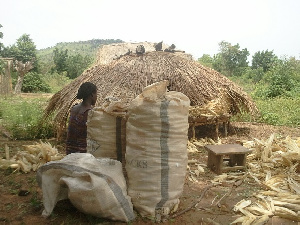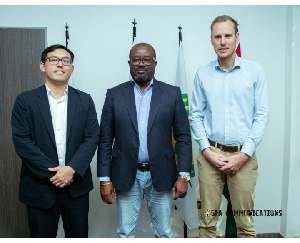Opinions of Thursday, 30 August 2018
Columnist: Prof Ramatu M. Al-Hassan
Achieving zero hunger in Ghana: An assessment of postharvest losses and market linkages
Hunger is a condition in which a person, for a sustained period, is unable to eat sufficient food to meet basic nutritional needs in terms of both macro and micro nutrients (JAK Foundation, 2017); hunger is at the centre of malnutrition. Eight hundred and fifteen million people globally, do not get enough food to lead a normal, active life (WFP, 2018). Available estimates suggest that at least 2 million Ghanaians are undernourished. This situation needs to change according to the Sustainable Development Goal 2, which aims to end hunger by 2030.
The World Food Programme in Ghana (WFP) commissioned the John Agyekum Kufuor Foundation to undertake a Zero Hunger Strategic Review (GZHSR) on behalf of the Government of Ghana, through the Ministry of Planning/National Development Planning Commission (NDPC). The objective of the GZHSR was to provide a baseline assessment of hunger, food insecurity and malnutrition, and the report aims to support a common understanding of the problems and how to solve them by 2030. The GZHSR report forms the basis of this review, which focuses on postharvest losses and weak market linkages as contributors to hunger and malnutrition.
Ghana hunger situation
According to the GZHSR report, despite achieving the MDG1 (halving poverty prevalence by 2015), hunger and malnutrition are still prevalent in the population and is characterised by a skewed spatial distribution with higher concentration in rural areas and northern Ghana. Extreme poverty is defined as those whose standard of living is insufficient to meet their basic nutritional requirements even if they devoted their entire consumption budget to food.
Extreme poverty rate in rural areas was 15 percent, compared to 2 percent of the urban population. Furthermore, the three northern regions have an extreme poverty rate of 29.7 percent, almost three times the national average. The Volta Region also had a prevalence rate of 9 percent. The outcomes of undernourishment are stunting and being underweight (children being too thin for their age) and hidden hunger (a situation of micronutrient deficiency). For example, two-thirds of children under five years are anaemic.
Causes
The GZHSR report identifies limited access of farmers to reliable markets for their produce, and high postharvest losses as some of the contributory factors to extreme poverty and undernourishment. Therefore, addressing the above challenges is central to the attainment of SDG 2.
Postharvest management and food losses
Postharvest loss is defined as the degradation in both quantity (physical loss in quantity) and quality (nutrient composition, acceptability and edibility). As a developing country, postharvest losses are high in Ghana, especially at the farmer level.
Estimates of postharvest losses vary according to the crop and method of estimation. What is clear is that the country loses quite a bit of agricultural produce to inappropriate management of harvested produce. Ghana loses over three hundred thousand tonnes of maize annually to postharvest losses .
A review of studies on postharvest losses in Ghana recorded very high upper limits of losses suffered by farmers; as high as 26 percent for cassava, 50 percent for maize, 94 percent for cowpea (Vowotor et al., 2013). The losses are also very high for processed products (e.g. 20.9 - 72 percent for cassava chips and gari, and 36 percent for yam chips). A loss of 50 percent of maize produced is not just loss of food or potential earnings, but also of investment in the production of the commodity, further impoverishing the farmer and other actors in the value chain.
The causes of losses are pests and diseases, poor storage and transportation practices that lead to bruising and physical damage including rotting. Agricultural produce in Ghana is not transported in fit-for-purpose vehicles such as cool vans for fresh produce (fruits, vegetables, fish and meats). Farmers and traders have poor or inadequate storage infrastructure, including drying and cleaning facilities . An inventory of commercial post-harvest infrastructure identified about 13000 warehouses, that have rather low levels of utilisation due to lack of trust in them by farmers.
Some of the facilities need additional enhancements such as drying platforms, cold stores and trained warehouse managers. The Peasant Farmers Association of Ghana has advocated for challenges such as bad road infrastructure, inadequate machinery, extension services, and adoption of simple post-harvest technologies to be urgently addressed . For liquidity reasons, farmers may also be pressured to sell at low prices as there are no risk management instruments to fall on.
Market linkages and food and nutrition security
The GZHSR has identified low producer prices and inability of farmers to sell their produce as market access challenges for farmers. Most agricultural producers participate in informal physical or cash markets, in which exchange is face-to-face, and most importantly selling is seldom linked to a specific off-taker. As a result, the farmer does not hedge to offset negative price fluctuations in an environment of high production seasonality.
The approach for linking smallholders to markets is participatory market development. In this approach, farmers are supported to identify market opportunities and to supply adequate quantities and quality on a regular and timely basis. Such support includes, helping farmers build their assets to produce what the market demands, providing them with information to take the right decisions, and continuous knowledge upgrading for them to stay competitive in the market. Availability of the right infrastructure, especially roads to physically link production areas to market centres is critical for enhancing market access.
Reducing postharvest losses and linking farmers to markets requires partnership between government, especially at the local level, farmers, other private sector actors and civil society.
The state provides needed public goods such infrastructure (including well designed and appropriately equipped markets), research, dissemination of knowledge and information, and enforcement of standards for marketing. In the special case of smallholders, smart subsidies such as matching grants may be used to help them acquire production assets, a strategy that has been used by agricultural development projects in this country. In fact the state can consider such subsidies as instruments of social protection.
Farmers on their part, need to reorient themselves to invest in meeting the demands of the market including standards. The private sector can engage smallholders in inclusive market models for mutual benefit. Civil society can advocate for appropriate policies for the farmers plus engage with farmers at the local level to support the market development (e.g. building skills for price negotiations and sensitising farmers on contract relations).
Conclusion
Achieving zero hunger in a decade may seem a tall order, but it is possible if the right partnerships are forged at the local level and an inclusive market systems development approach is adopted.











